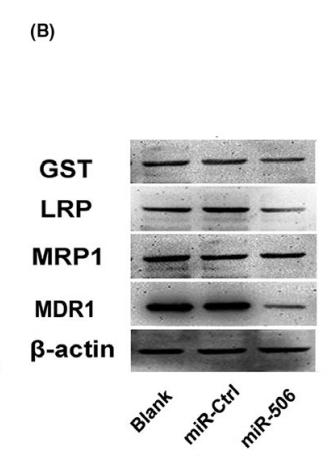ABCC1 Antibody - #DF7148
| Product: | ABCC1 Antibody |
| Catalog: | DF7148 |
| Description: | Rabbit polyclonal antibody to ABCC1 |
| Application: | WB IHC |
| Cited expt.: | WB |
| Reactivity: | Human, Mouse, Rat |
| Prediction: | Zebrafish |
| Mol.Wt.: | 150-220kD; 172kD(Calculated). |
| Uniprot: | P33527 |
| RRID: | AB_2839101 |
Product Info
*The optimal dilutions should be determined by the end user. For optimal experimental results, antibody reuse is not recommended.
*Tips:
WB: For western blot detection of denatured protein samples. IHC: For immunohistochemical detection of paraffin sections (IHC-p) or frozen sections (IHC-f) of tissue samples. IF/ICC: For immunofluorescence detection of cell samples. ELISA(peptide): For ELISA detection of antigenic peptide.
Cite Format: Affinity Biosciences Cat# DF7148, RRID:AB_2839101.
Fold/Unfold
ABC 29; ABC29; ABCC 1; ABCC; Abcc1; ATP binding cassette sub family C (CFTR/MRP) member 1; ATP binding cassette sub-family C member 1; ATP binding cassette subfamily C member 1; ATP binding cassette transporter variant ABCC1delta ex13; ATP binding cassette transporter variant ABCC1delta ex13&14; ATP binding cassette transporter variant ABCC1delta ex25; ATP binding cassette transporter variant ABCC1delta ex25&26; ATP binding cassette, sub-family C (CFTR/MRP), member 1; ATP-binding cassette sub-family C member 1; DKFZp686N04233; DKFZp781G125; GS X; GSX; Leukotriene C(4) transporter; LTC4 transporter; MRP 1; MRP; MRP1; MRP1_HUMAN; Multidrug resistance associated protein 1; Multidrug resistance protein; Multidrug resistance-associated protein 1; Multiple drug resistance associated protein; Multiple drug resistance protein 1;
Immunogens
A synthesized peptide derived from human ABCC1, corresponding to a region within N-terminal amino acids.
- P33527 MRP1_HUMAN:
- Protein BLAST With
- NCBI/
- ExPASy/
- Uniprot
MALRGFCSADGSDPLWDWNVTWNTSNPDFTKCFQNTVLVWVPCFYLWACFPFYFLYLSRHDRGYIQMTPLNKTKTALGFLLWIVCWADLFYSFWERSRGIFLAPVFLVSPTLLGITMLLATFLIQLERRKGVQSSGIMLTFWLVALVCALAILRSKIMTALKEDAQVDLFRDITFYVYFSLLLIQLVLSCFSDRSPLFSETIHDPNPCPESSASFLSRITFWWITGLIVRGYRQPLEGSDLWSLNKEDTSEQVVPVLVKNWKKECAKTRKQPVKVVYSSKDPAQPKESSKVDANEEVEALIVKSPQKEWNPSLFKVLYKTFGPYFLMSFFFKAIHDLMMFSGPQILKLLIKFVNDTKAPDWQGYFYTVLLFVTACLQTLVLHQYFHICFVSGMRIKTAVIGAVYRKALVITNSARKSSTVGEIVNLMSVDAQRFMDLATYINMIWSAPLQVILALYLLWLNLGPSVLAGVAVMVLMVPVNAVMAMKTKTYQVAHMKSKDNRIKLMNEILNGIKVLKLYAWELAFKDKVLAIRQEELKVLKKSAYLSAVGTFTWVCTPFLVALCTFAVYVTIDENNILDAQTAFVSLALFNILRFPLNILPMVISSIVQASVSLKRLRIFLSHEELEPDSIERRPVKDGGGTNSITVRNATFTWARSDPPTLNGITFSIPEGALVAVVGQVGCGKSSLLSALLAEMDKVEGHVAIKGSVAYVPQQAWIQNDSLRENILFGCQLEEPYYRSVIQACALLPDLEILPSGDRTEIGEKGVNLSGGQKQRVSLARAVYSNADIYLFDDPLSAVDAHVGKHIFENVIGPKGMLKNKTRILVTHSMSYLPQVDVIIVMSGGKISEMGSYQELLARDGAFAEFLRTYASTEQEQDAEENGVTGVSGPGKEAKQMENGMLVTDSAGKQLQRQLSSSSSYSGDISRHHNSTAELQKAEAKKEETWKLMEADKAQTGQVKLSVYWDYMKAIGLFISFLSIFLFMCNHVSALASNYWLSLWTDDPIVNGTQEHTKVRLSVYGALGISQGIAVFGYSMAVSIGGILASRCLHVDLLHSILRSPMSFFERTPSGNLVNRFSKELDTVDSMIPEVIKMFMGSLFNVIGACIVILLATPIAAIIIPPLGLIYFFVQRFYVASSRQLKRLESVSRSPVYSHFNETLLGVSVIRAFEEQERFIHQSDLKVDENQKAYYPSIVANRWLAVRLECVGNCIVLFAALFAVISRHSLSAGLVGLSVSYSLQVTTYLNWLVRMSSEMETNIVAVERLKEYSETEKEAPWQIQETAPPSSWPQVGRVEFRNYCLRYREDLDFVLRHINVTINGGEKVGIVGRTGAGKSSLTLGLFRINESAEGEIIIDGINIAKIGLHDLRFKITIIPQDPVLFSGSLRMNLDPFSQYSDEEVWTSLELAHLKDFVSALPDKLDHECAEGGENLSVGQRQLVCLARALLRKTKILVLDEATAAVDLETDDLIQSTIRTQFEDCTVLTIAHRLNTIMDYTRVIVLDKGEIQEYGAPSDLLQQRGLFYSMAKDAGLV
Predictions
Score>80(red) has high confidence and is suggested to be used for WB detection. *The prediction model is mainly based on the alignment of immunogen sequences, the results are for reference only, not as the basis of quality assurance.
High(score>80) Medium(80>score>50) Low(score<50) No confidence
Research Backgrounds
Mediates export of organic anions and drugs from the cytoplasm. Mediates ATP-dependent transport of glutathione and glutathione conjugates, leukotriene C4, estradiol-17-beta-o-glucuronide, methotrexate, antiviral drugs and other xenobiotics. Confers resistance to anticancer drugs by decreasing accumulation of drug in cells, and by mediating ATP- and GSH-dependent drug export. Hydrolyzes ATP with low efficiency. Catalyzes the export of sphingosine 1-phosphate from mast cells independently of their degranulation. Participates in inflammatory response by allowing export of leukotriene C4 from leukotriene C4-synthezing cells (By similarity).
Cell membrane>Multi-pass membrane protein.
Lung, testis and peripheral blood mononuclear cells.
Belongs to the ABC transporter superfamily. ABCC family. Conjugate transporter (TC 3.A.1.208) subfamily.
Research Fields
· Environmental Information Processing > Membrane transport > ABC transporters.
· Environmental Information Processing > Signal transduction > Sphingolipid signaling pathway. (View pathway)
· Human Diseases > Drug resistance: Antineoplastic > Antifolate resistance.
· Human Diseases > Cancers: Overview > MicroRNAs in cancer.
· Organismal Systems > Digestive system > Vitamin digestion and absorption.
References
Application: WB Species: human Sample:
Application: WB Species: Rat Sample: hippocampus
Restrictive clause
Affinity Biosciences tests all products strictly. Citations are provided as a resource for additional applications that have not been validated by Affinity Biosciences. Please choose the appropriate format for each application and consult Materials and Methods sections for additional details about the use of any product in these publications.
For Research Use Only.
Not for use in diagnostic or therapeutic procedures. Not for resale. Not for distribution without written consent. Affinity Biosciences will not be held responsible for patent infringement or other violations that may occur with the use of our products. Affinity Biosciences, Affinity Biosciences Logo and all other trademarks are the property of Affinity Biosciences LTD.



